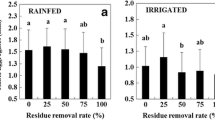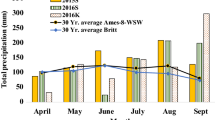Abstract
Removing plant residue from soil has been shown to have an adverse effect on soil health; however, the addition of cover crops may help mitigate these impacts. This study was conducted to assess the effect of incorporating cover crops on soil health with varying removal rates of corn (Zea mays L.) residues. Corn was grown in rotation with soybean (Glycine max) in a randomized, split-block design with three different corn residue removal levels (37, 55, and 98% of total above-ground C) as whole plot treatments and the presence or absence of cover crops as the split plot treatment. Soil samples were collected from both crop phases following 7 years of cover crop treatment and subjected to a suite of soil health measurements. In the soybean phase immediately following corn residue removal, there were significant (P = 0.025) increases in the erodible fraction (EF) of soil aggregates and reductions in the stable, larger aggregate fractions. Cover crops mitigated these changes in aggregate distributions in the highest residue removal treatment. Residue removal resulted in a significant decrease in fPOM (P = 0.03) while the addition of cover crops increased fPOM levels during the soybean phase (P = 0.002). Residue removal significantly (P = 0.017) decreased soil microbial enzyme activities while cover crops restored activities in the highest residue removal treatment (P = 0.037). We also found higher fungal:bacterial ratios with cover cropping compared to no cover crops. We conclude that cover cropping continued over multiple years can partially mitigate negative effects of crop residue removal on soil health thus limiting soil erosion and maintaining nutrient cycling activities in the vulnerable period following residue removal.
Similar content being viewed by others
Abbreviations
- LRR:
-
Low residue removal
- MRR:
-
Medium residue removal
- HRR:
-
High residue removal
- EF:
-
Erodible fraction
- SOM:
-
Soil organic matter
- POM:
-
Particulate organic matter
- tPOM:
-
Total particulate organic matter
- cPOM:
-
Coarse particulate organic matter
- fPOM:
-
Fine particulate organic matter
- FDA:
-
Fluorescein diacetate
- DASD:
-
Dry aggregate size distribution
- MWD:
-
Mean weight diameter
References
Graham RL, Nelson R, Sheehan J, Perlack RD, Wright LL (2007) Current and potential U.S. corn stover supplies. Agron J 99(1):1–11. https://doi.org/10.2134/agronj2005.0222
Kim S, Dale BE (2004) Global potential bioethanol production from wasted crops and crop residues. Biomass Bioenergy 26(4):361–375. https://doi.org/10.1016/j.biombioe.2003.08.002
Blanco-Canqui H, Lal R (2007) Soil and crop response to harvesting corn residues for biofule production. Geoderma 14:355–362
Blanco-Canqui H, Lal R (2009) Crop residue removal impacts on soil productivity and environmental quality. Crit Rev Plant Sci 28(3):139–163. https://doi.org/10.1080/07352680902776507
Johnson JMF, Acosta-Martinez V, Cambardella CA, Barbour NW (2013) Crop and soil responses to using corn stover as a bioenergy feedstock: observations from the Northern US corn belt. Agriculture 13:72–89
Wilhelm WW, Johnson JMF, Hatfield JL, Voorhees WB, Linden DR (2004) Crop and soil productivity response to corn residue removal: a literature revies. Agron J 96(1):1–17. https://doi.org/10.2134/agronj2004.0001
Muth D Jr, Bryden KM, Nelson R (2013) Sustainable agricultural residue removal for bioenergy: a spatially comprehensive US national assessment. Appl Energy 102:403–417. https://doi.org/10.1016/j.apenergy.2012.07.028
Stetson SJ, Osborne SL, Schumacher TE, Eynard A, Chilom G, Rice J, Nichols KA, Pikul JL (2012) Corn residue removal impact on topsoil organic carbon in a corn–soybean rotation. Soil Sci Soc Am J 76:1390–1398
Blanco-Canqui H, Lal R, Post WM, Izaurraldae RC, Owens LB (2006) Rapid changes in soil carbon and structural properties due to stover removal from no-till corn plots. Soil Sci 171(6):468–482. https://doi.org/10.1097/01.ss.0000209364.85816.1b
Blanco-Canqui H, Lal R (2009) Corn stover removal for expanded uses reduces soil fertility and structural stability. Soil Sci Soc Am J 73(2):418–426. https://doi.org/10.2136/sssaj2008.0141
Lehman RM, Osborne SL (2016) Soil greenhouse gas emissions and carbon dynamics of a no-till, corn-based cellulosic ethanol production system. BioEnergy Res 9(4):1101–1108. https://doi.org/10.1007/s12155-016-9754-y
Hammerbeck AL, Stetson SJ, Osborne SL, Schumacher TE, Pikul JL (2012) Corn residue removal impact on soil aggregates in a no-till corn/soybean rotation. Soil Sci Soc Am J 76(4):1390–1398. https://doi.org/10.2136/sssaj2011.0421
Karlen DL, Wollenhaupt NC, Erbach DC, Berry EC, Swan JB, Eash NS, Jordahl JL (1994) Crop residue effects on soil quality following 10-years of no-till corn. Soil Tillage Res 31(2-3):149–167. https://doi.org/10.1016/0167-1987(94)90077-9
Osborne SL, Johnson JM, Jin VL, Hammerbeck AL, Varvel GE, Schumacher TE (2014) The impact of corn residue removal on soil aggregates and particulate organic matter. BioEnergy Res 7(2):559–567. https://doi.org/10.1007/s12155-014-9413-0
Lehman RM, Ducey TF, Jin VL, Acosta-Martinez V, Ahlschwede CM, Jeske ES, Drijber RA, Cantrell KB, Frederick JR, Fink DM (2014) Soil microbial community response to corn stover harvesting under rain-fed, no-till conditions at multiple US locations. BioEnergy Res 7(2):540–550. https://doi.org/10.1007/s12155-014-9417-9
Hartwig NL, Ammon HU (2002) Cover crops and living mulches. Weed Sci 50(6):688–699
Blanco-Canqui H, Mikha MM, Presley DR, Claassen MM (2011) Addition of cover crops enhances no-till potential for improving soil physical properties. Soil Sci Soc Am J 75(4):1471–1482. https://doi.org/10.2136/sssaj2010.0430
Gianinazzi S, Gollotte A, Binet M-N, van Tuinen D, Redecker D, Wipf D (2010) Agroecology: the key role of arbuscular mycorrhizas in ecosystem services. Mycorrhiza 20(8):519–530. https://doi.org/10.1007/s00572-010-0333-3
Wegner BR, Kumar S, Osborne S, Schumacher TE, Vahyala IE, Eynard A (2015) Soil response to corn residue removal and cover crops in Eastern South Dakota. Soil Sci Soc Am J 79(4):1179–1187. https://doi.org/10.2136/sssaj2014.10.0399
Chepil WS (1962) Compact rotary sieve and the importance of dry sieving in physical soil analysis. Soil Sci Soc Proc 4–6
Youker R, McGuinness J (1957) A short method of obtaining mean weight-diameter values of aggregate analyses of soils. Soil Sci 83(4):291–294. https://doi.org/10.1097/00010694-195704000-00004
Merrill SD, Black AL, Fryrear DW, Saleh A, Zobeck TM, Halvorson AD, Tanaka DL (1999) Soil wind erosion hazard of spring wheat–fallow as affected by long-term climate and tillage. Soil Sci Soc Am J 63(6):1768–1777. https://doi.org/10.2136/sssaj1999.6361768x
Adam G, Duncan H (2001) Development of a sensitive and rapid method for the measurement of total microbial activity using fluorescein diactate (FDA) in a range of soils. Soil Biol Biochem 33(7-8):943–951. https://doi.org/10.1016/S0038-0717(00)00244-3
Cambardella C, Gajda A, Doran J, Wienhold B, Kettler T (2001) Estimation of particulate and total organic matter by weight loss-on-ignition. Assess Methods Soil Carbon 349–359
Fierer N, Jackson JA, Vilgalys R, Jackson RB (2005) Assessment of soil microbial community structure by use of taxon-specific quantitive PCR assays. Appl Environ Microbiol 71(7):4117–4120. https://doi.org/10.1128/AEM.71.7.4117-4120.2005
Littell R, Milliken G, Stroup W, Wolfinger R (1996) SAS system for mixed models. SAS Institute. Inc, Cary
Six J, Elliott E, Paustian K (2000) Soil macroaggregate turnover and microaggregate formation: a mechanism for C sequestration under no-tillage agriculture. Soil Biol Biochem 32(14):2099–2103. https://doi.org/10.1016/S0038-0717(00)00179-6
Pikul JL, Osborne S, Ellsbury M, Riedell W (2007) Particulate organic matter and water-stable aggregation of soil under contrasting management. Soil Sci Soc Am J 71(3):766–776. https://doi.org/10.2136/sssaj2005.0334
Six J, Elliott E, Paustian K, Doran J (1998) Aggregation and soil organic matter accumulation in cultivated and native grassland soils. Soil Sci Soc Am J 62(5):1367–1377. https://doi.org/10.2136/sssaj1998.03615995006200050032x
Kallenbach CM, Frey SD, Grandy AS (2016) Direct evidence for microbial-derived soil organic matter formation and its ecophysiological controls. Nat Commun 7. https://doi.org/10.1038/ncomms13630
Six J, Bossuyt H, Degryze S, Denef K (2004) A history of research on the link between (micro) aggregates, soil biota, and soil organic matter dynamics. Soil Tillage Res 79(1):7–31. https://doi.org/10.1016/j.still.2004.03.008
Mikha M, Vigil M, Liebig M, Bowman R, McConkey B, Deibert E, Pikul J (2006) Cropping system influences on soil chemical properties and soil quality in the Great Plains. Renew Agric Food Syst 21(01):26–35. https://doi.org/10.1079/RAFS2005123
Moebius-Clune BN, Van Es HM, Idowu OJ, Schindelbeck RR, Moebius-Clune DJ, Wolfe DW, Abawi GS, Thies JE, Gugino BK, Lucey R (2008) Long-term effects of harvesting maize stover and tillage on soil quality. Soil Sci Soc Am J 72(4):960–969. https://doi.org/10.2136/sssaj2007.0248
Bandick AK, Dick RP (1999) Field management effects on soil enzyme activities. Soil Biol Biochem 31(11):1471–1479. https://doi.org/10.1016/S0038-0717(99)00051-6
Nakamoto T, Komatsuzaki M, Hirata T, Araki H (2012) Effects of tillage and winter cover cropping on microbial substrate-induced respiration and soil aggregation in two Japanese fields. Soil Sci Plant Nutr 58(1):70–82. https://doi.org/10.1080/00380768.2011.650134
Wienhold BJ, Varvel GE, Johnson JMF, Wilhelm WW (2013) Carbon source quality and placement effects on soil organic carbon status. Bioenerg Res 6(2):786–796. https://doi.org/10.1007/s12155-013-9301-z
de Vries FT, Bloem J, Quirk H, Stevens CJ, Bol R, Bardgett RD (2012) Extensive management promotes plant and microbial nitrogen retention in temperate grassland. PLoS One 7(12):e51201. https://doi.org/10.1371/journal.pone.0051201
de Vries FT, Thébault E, Liiri M, Birkhofer K, Tsiafouli MA, Bjørnlund L, Jørgensen HB, Brady MV, Christensen S, de Ruiter PC (2013) Soil food web properties explain ecosystem services across European land use systems. Proc Natl Acad Sci 110(35):14296–14301
Six J, Frey S, Thiet R, Batten K (2006) Bacterial and fungal contributions to carbon sequestration in agroecosystems. Soil Sci Soc Am J 70(2):555–569. https://doi.org/10.2136/sssaj2004.0347
Author information
Authors and Affiliations
Corresponding author
Additional information
The use of trade, firm, or corporation names in this publication is for the information and convenience of the reader. Such use does not constitute an official endorsement or approval by the United States Department of Agriculture or the Agricultural Research Service of any product or service to the exclusion of others that may be suitable.
The USDA is an equal opportunity provider and employer.
Rights and permissions
About this article
Cite this article
Wegner, B.R., Osborne, S.L., Lehman, R.M. et al. Seven-Year Impact of Cover Crops on Soil Health When Corn Residue Is Removed. Bioenerg. Res. 11, 239–248 (2018). https://doi.org/10.1007/s12155-017-9891-y
Published:
Issue Date:
DOI: https://doi.org/10.1007/s12155-017-9891-y




